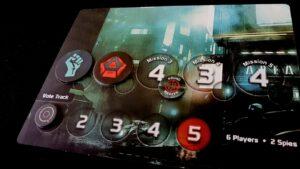For this week’s critical play, I played The Resistance with five of my friends (one of which owned the physical version of the game). The Resistance is a social deduction board game designed by Don Eskridge with a target audience of adults and older teenagers who enjoy strategic and social gameplay. It allows for groups of 5 to 10.
The Resistance emphasizes social deduction through its hidden roles, voting system, mission results, and dynamic gameplay. At its core, the hidden roles of The Resistance create an atmosphere of uncertainty and suspicion vital to social deduction games. Players are either members of the Resistance or spies of the Empire working against them, and only the spies know who their partners are. Since we had six players, there were two spies in each round we played, so four of us were in the dark about who was working with or against us’ this made us rely on observation and persuasion to figure it out. As for the voting system, throughout the game we built teams to go on missions (with a different number of people on the team for each mission) and were able to approve or deny the proposed teams. This phase was crucial in the social deduction part of gameplay because spies will want a member of their team on missions to fail them and members of the Resistance will want no spies so that the mission succeeds. Thus, players could deduce based on conversation and voting on missions which team another player may belong to. Once the mission results were revealed, it let players see if at least one member of the team was a spy. This contributed to social deduction as spies tried to convince the group that another team member was a spy while other members of the group attempted to figure out which of them was the spy. Finally, social deduction is evident in the dynamic gameplay of The Resistance. Strategies change from round to round as spies or the Resistance succeed in missions, so players must also adapt to create shifting alliances, betrayals, and social interactions in general.
One thing I noticed about The Resistance is that the people who had already played the game before had strategies lined up for how to best play it. Sometimes they would share these to convince the rest of the group to side with them, but as a new player, I think it would have taken me a while to discover those strategies. As such, I think it would be nice to include a mock round with the game that includes some common strategies. For example, the friend who owned the game was a spy in the first round but played a success card in the first mission when he was chosen to trick the rest of the group into trusting him. Then, he failed the second mission and blamed it on a different member of the team.

This seems to be a fairly simple strategy, and I would love for it and similarly-leveled strategies to be evident and level the playing field for new players. Another aspect that I noticed was the lack of special roles in the game. I have played Avalon before, which is a spinoff of The Resistance, and I had a lot of fun with the different roles present in the game, from Merlin to Oberon. While I don’t think The Resistance necessarily needs roles to succeed- I had a lot of fun without them- this aspect differentiates it from similar games that give specialized actions to the player card that you are assigned. Its strength is its view of Resistance members as a collective working toward a goal, rather than many powerful individuals.
The core mechanics of The Resistance which I outlined drive player interaction and strategic decision-making. However, while these mechanics effectively create tensions and uncertainty, there is the potential to amplify these effects. For example, voting on missions could be anonymous to increase the likelihood of deception. The dynamics of the game evolve throughout as players make alliances and accuse others. While captivating, there is a risk of dominant strategies always winning; for example, the first two games we played had the spies winning because of strategies that experienced players developed a long time ago. This detracted from the balance until new players could learn these strategies and devise their own. While not unusual for games like this, this can detract from the overall enjoyment of the game. The aesthetics contribute to the atmosphere of struggle and uncertainty; however, the mechanics drive this game.
Overall I had a lot of fun playing The Resistance and comparing it to similar games in the genre.



